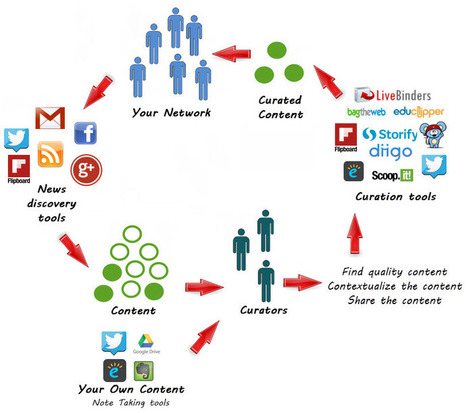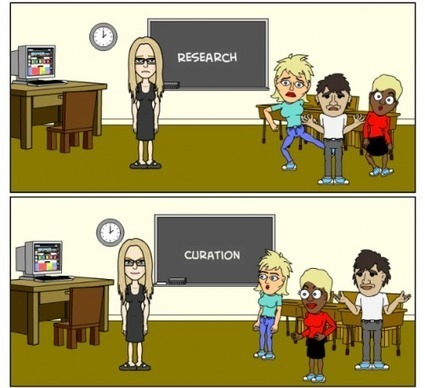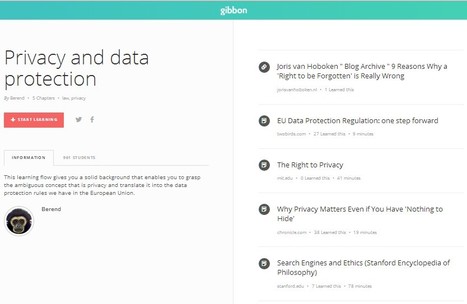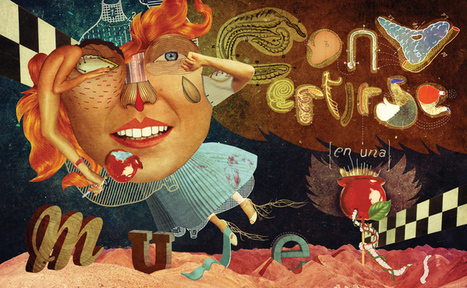Via Robin Good
Get Started for FREE
Sign up with Facebook Sign up with X
I don't have a Facebook or a X account
 Your new post is loading... Your new post is loading...
 Your new post is loading... Your new post is loading...

Gianfranco Marini's curator insight,
February 26, 2014 10:44 AM
Traduco approssimativamente quanto scritto da Robin Good.
Una raccolta di risorse sulla content curation che raccoglie diversi articoli 60, (in lingua inglese) e li organizza in 8 categorie principali:
1. perché c'è bisogno della curation? 2. Che cos'è la digital curation? 3. aggregazione o curation? 4. tutto sull'audience 5. dove è possibile trovare contenuti di valore 6. che cosa selezionare? 7. strumenti di curation 8, contributi dei partecipanti del corso
Gli articoli sono stati ordinati in categorie utilizzando Pearltrees, questo lavoro rappresenta il risultato di un corso sulla content curation 
Ali Anani's curator insight,
March 4, 2014 12:37 AM
Curate and scoop it- this one shows you how to curate effectively 
Christoph Meier's curator insight,
March 11, 2014 9:38 AM
Robin Good's insight:
Here's a valuable resource on content curation, "distilled" by the students of the DCurate MOOC lead Martin Couzins and Sam Burrough which organizes over 60 different articles, guides and tools on the topic.
This resources collection is presented in the form of a Pearltrees interactive map, organized into eight sections:
1. Why Do We Need Curators
2. What Is Digital Curation
3. Aggregation vs. Curation
4. It's All About Audience
5. How Do We Find Valuable Content
6. How Do You Decide What To Curate
7. Curation Tools
8. Contributions from participants
If you are new to content curation this is a good resource to bookmark and keep as a reference.
DCurate MOOC sign-up: http://www.curatr3.com/portfolio-item/how-to-be-an-effective-digital-curator/ ; See also: http://sco.lt/99a09Z ;
Free to use.
Explore the guidemap: http://bit.ly/digitalcuratorguidemap ;
See also: https://gibbon.co/RobinGood/content-curation-guide ;

Alfredo Corell's curator insight,
October 3, 2013 5:48 PM
An excellent story for lecturers or teachers thinking in content curation as a tool in their aulas. 
Fiona Harvey's curator insight,
October 8, 2013 2:22 AM
Useful for educators - key digital literacy skill 
johanna krijnsen's curator insight,
December 4, 2013 2:00 PM
content curation and critical thinking skills |

Maria Persson's curator insight,
March 21, 2014 12:11 AM
If you are considering being a teacher for this and the next generation - take a few tips from this scoop! 
Audrey's curator insight,
March 21, 2014 7:30 PM
Curating is about finding and selecting information in order to learn about a subject. Youngsters can be encouraged to do this pre-school. This motivational 21st century skill can be encouraged at home. with educational games toys and and books which stimulates interest. For example children can learn about science by interacting with Chemistry Lab; Horrible Science - explosive experiments; Newton's Cradle and Science Museum. By the time they get to school they are already full of curiosity and ready to increase their knowledge. Audrey curating for www.homeschoolsource.co.uk 
Monica S Mcfeeters's curator insight,
March 30, 2014 9:27 AM
By Robin Good, Here's a short first-hand report highlighting how an 8th grade social studies class teacher (Terri Inloes) has fully leveraged the content curation potential to let her students dive, discover and make sense of topics (in this case social reform movements) that they had not studied before. All by themselves. Here the steps taken to make this happen: a) By using the Question Formulation Technique, the teacher prepared pairs of photographs representing each of the reform movements, one picture dating back to the late 19th century, and another representing where that social reform movement stands in today’s society. b) After checking out all of the photos, students settled on the pair of pictures that most caught their interest. c) They brainstormed and refined a set of specific questions, and then shared their thinking with the class. e) At this point students planned their research strategies. By using 5 different graphic organizers from the book Q Tasks, by Carol Koechlin and Sandi Zwaan, students were allowed to choose the one that they thought would help them the most in planning their keyword search strategies. f) Students were assigned WordPress blogs and provided basic instructions on how to use them to curate and publish their research work. g) Discovery and real learning kicked in as students proceeded in collaborative groups to research and document their chosen topic. You can see some of the outcomes that this assignment produced right here: General Conclusions http://tmsredvotingrights.d20blogs.org/2014/02/24/conclusion-3/ Voting Rights Inequality http://tmsredvotingrights.d20blogs.org/ Mental Health Treatment Prohibition Acts http://tmsorangeprohibitionacts.d20blogs.org/
A very inspiring example of content curation can be effectively applied in the classroom with impressive results. Highly recommended. 9/10 Thanks to Nancy White of Innovations in Education for participating, writing and reporting about it. Thanks to Robin Good for the fine summary in this insight. The ideas here offer a great classroom challenge to students.{Monica}

Robin Good's curator insight,
January 3, 2014 1:28 PM
Gibbon is a new web app which makes it extremely easy to create beautiful-to-look-at learning playlists by simply adding specific article or video links to your custom-made content compilation. Gibbon actually goes the extra mile by grabbing the full content from each original source you curate, by integrating it into your learning playlist, and by stripping out of any design distractions it may have been accompanied by. Learning playlists can be easily edited, arranged and shared with others. Gibbon offers a wonderful and elegant design, providing a clutter-free, elegant and very effective way to present and organize content lists. Furthermore Gibbon adds a few specific touches that make this curation tool particularly fit for learning a topic, by providing reading time estimates for each link in a list, striking out titles of completed readings, highlighting with simple icons the type of content showcased (articles, video, etc.), and creating a focused and distraction-free reading environment. My comment: Gibbon looks very promising to me, as it attempts not to be another generic curation tool but addresses a very specific need and application while providing a very well designed and usable tool. Notwithstanding the beauty and simplicity of the UI I felt the need for an integrated search tool that would facilitate me in grabbing those content items I wanted to add into a learning playlist. I also had several problems in trying to add new content to my test playlist. New URLs would "time out" easily while being fetched and all of the content added via the bookmarklet or the Google extension didn't show up in my collection. A very promising tool to effectively curate content learning playlists. Free to use. Try it out now: https://gibbon.co/ Added to the Curation for Learning Tools section of the Content Curation Tools Supermap. 
M Dolores Solé Gómez's curator insight,
January 4, 2014 5:56 AM
Great! Thank you for sharing this tool. 
Terry Yelmene's curator insight,
January 5, 2014 2:35 AM
This may be useful, if it proves easy enough.
Sample Student's curator insight,
May 5, 2015 10:14 PM
We often ask our students to create annotated bibliographies, and this focuses on their capacity to evaluate and make decisions about the validity, reliability and relevance of sources they have found. using Scoop.it, we can ask them to do much the same thing, but they will publish their ideas for an audience, and will also be able to provide and use peer feedback to enhance and tighten up their thinking. This is relevant to any curriculum area. Of course it is dependent on schools being able to access any social media, but rather than thinking about what is impossible, perhaps we could start thinking about what is possible and lobbying for change.
Sample Student's curator insight,
May 5, 2015 10:18 PM
We often ask our students to create annotated bibliographies, and this focuses on their capacity to evaluate and make decisions about the validity, reliability and relevance of sources they have found. Using Scoop.it, we can ask them to do much the same thing. But they will publish their ideas for an audience, and will also be able to provide and use peer feedback to enhance and tighten up their thinking. This is relevant to any age, and any curriculum area. Of course it is dependent on schools being able to access social media. But rather than thinking about what is impossible, perhaps we should start thinking about what is possible, and lobbying for change. Could you use a Scoop.it collection as an assessment task? |

















An absolutely significant skill in any research or investigation, for educators and learners in the digital age - the curation of content- with a clear focus or question in mind, the capacity to target a search field, sift through, reflect on and make decisions about the most suitable resource or evidence to use. What a great learning experience.
Forstå og komme i gang med kurator tjenester.